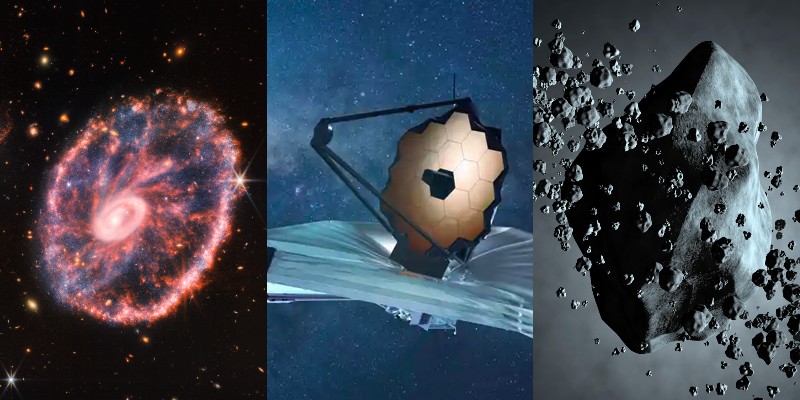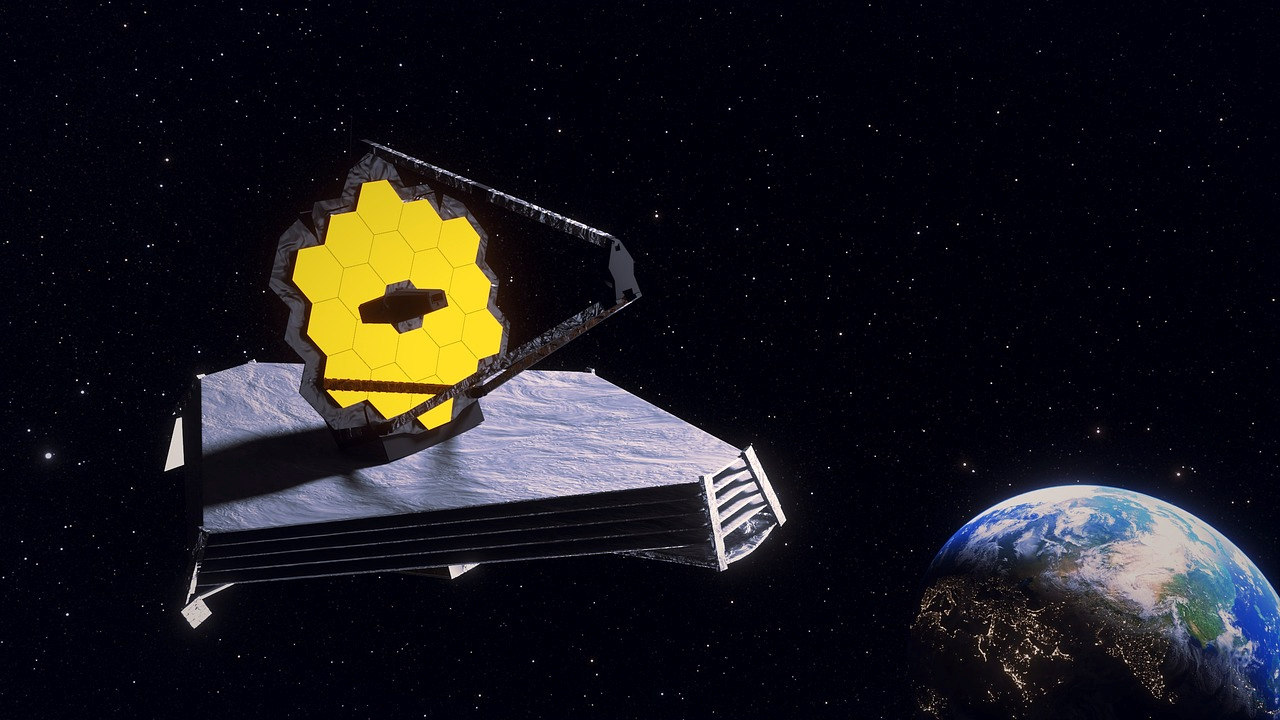Introduction to the James Webb Space Telescope (JWST)

The James Webb Space Telescope (JWST), named after the second administrator of NASA, is an ambitious project that promises to revolutionize our understanding of the universe. As the most powerful space telescope ever built, the JWST will enable scientists to peer back in time and observe the early universe with unprecedented clarity and detail. Scheduled to launch in 2021, the JWST represents a significant leap forward in space exploration and promises to unlock the mysteries of the cosmos.
The History and Development of the JWST
The idea for the James Webb Space Telescope can be traced back to the early 1990s when astronomers recognized the need for a successor to the Hubble Space Telescope. The Hubble, while groundbreaking, had limitations due to its relatively small size and the fact that it operated in the visible and ultraviolet parts of the electromagnetic spectrum. The development of the JWST began in 1996 as a collaboration between NASA, the European Space Agency (ESA), and the Canadian Space Agency (CSA).
The construction of the JWST has been a complex and challenging endeavor. Its large size and intricate design have required the integration of cutting-edge technologies and the collaboration of scientists and engineers from around the world. One of the primary goals of the JWST is to observe the universe in the infrared part of the spectrum, which is crucial for studying the formation of stars and galaxies, as well as the origins of life.
How the JWST Differs from Previous Space Telescopes
The James Webb Space Telescope represents a significant departure from previous space telescopes in terms of its size, capabilities, and observing techniques. Unlike the Hubble Space Telescope, which was primarily designed to observe the visible and ultraviolet parts of the spectrum, the JWST is optimized for observing in the infrared. This is because infrared light can penetrate dust clouds and reveal the hidden structures of star formation and galaxy evolution.
Another key difference is the size of the JWST. With a primary mirror that measures 6.5 meters in diameter, the JWST is more than two and a half times larger than the Hubble. This larger mirror allows the JWST to collect more light, resulting in higher-resolution images and the ability to detect fainter objects in the universe. Additionally, the JWST is equipped with a suite of scientific instruments that are specifically designed to exploit the capabilities of its large mirror and infrared detectors.
Key Features and Capabilities of the JWST
The James Webb Space Telescope is equipped with several advanced features and capabilities that make it a game-changer in the field of space exploration. One of its key features is its primary mirror, which is made up of 18 hexagonal segments that unfold and lock into place after the telescope is launched. This segmented mirror design allows for greater flexibility and stability and enables the JWST to observe a larger area of the sky with exceptional clarity.
In addition to its large mirror, the JWST is equipped with a suite of scientific instruments that cover a wide range of wavelengths in the infrared spectrum. These instruments include a near-infrared camera, a near-infrared spectrograph, a mid-infrared instrument, and a fine guidance sensor. Each instrument is designed to capture specific types of data, such as images, spectra, and polarimetry, which will enable scientists to address a wide range of scientific questions.
Another key capability of the JWST is its ability to perform precise and continuous pointing. This is achieved through the use of a fine guidance sensor, which is capable of measuring the position of stars with extraordinary accuracy. This precise pointing capability is crucial for conducting detailed observations and ensures that the JWST can gather high-quality data for its scientific investigations.
The Scientific Goals and Objectives of the JWST
The James Webb Space Telescope has a diverse range of scientific goals and objectives that will advance our understanding of the universe across multiple fields of study. One of its primary objectives is to investigate the formation and evolution of galaxies, including the first galaxies that formed in the early universe. By observing the light from these distant galaxies, the JWST will provide valuable insights into the processes that shaped the cosmos.
Another important scientific goal of the JWST is to study the formation of stars and planetary systems. The telescope will be able to peer through the dusty regions of space where stars are born, allowing scientists to better understand the physical processes involved in star formation. Additionally, the JWST will be able to study the atmospheres of exoplanets, providing valuable information about their composition and potential habitability.
The JWST will also contribute to our understanding of the origins of life by studying the chemical composition of distant objects in the universe. By analyzing the spectra of these objects, scientists will be able to identify the presence of organic molecules and other building blocks of life. This research will help answer fundamental questions about the potential for life beyond Earth and the conditions necessary for its existence.
The Impact of the JWST on Space Exploration and Our Understanding of the Universe
The James Webb Space Telescope has the potential to revolutionize our understanding of the universe and reshape the field of space exploration. By observing the universe in the infrared part of the spectrum, the JWST will reveal a wealth of information that is currently hidden from our view. This will enable scientists to address fundamental questions about the origins of galaxies, stars, and planets, as well as the conditions necessary for life to exist.
The JWST’s unprecedented capabilities will also have a significant impact on other areas of scientific research. For example, the telescope’s ability to observe distant galaxies will contribute to our understanding of the evolution of the universe and the nature of dark matter and dark energy. Additionally, the JWST’s observations of exoplanet atmospheres will provide valuable insights into the potential habitability of other planets and the likelihood of finding extraterrestrial life.
Furthermore, the JWST will inspire future generations of scientists and engineers and serve as a testament to the power of human ingenuity and exploration. Just as the Hubble Space Telescope has captured the public’s imagination and transformed our understanding of the cosmos, the JWST has the potential to do the same and pave the way for even greater discoveries in the future.
Challenges and Obstacles Faced in Building and Launching the JWST
The construction and launch of the James Webb Space Telescope have not been without challenges and obstacles. One of the primary challenges is the sheer size and complexity of the telescope. The JWST is significantly larger and more complex than any previous space telescope, requiring innovative engineering solutions and careful coordination between multiple international partners.
Another challenge is the extreme environment in which the JWST will operate. Unlike the Hubble Space Telescope, which was serviced and repaired by astronauts, the JWST will be located at a distance of approximately 1.5 million kilometers from Earth. This means that the telescope must be designed to withstand the harsh conditions of space and operate autonomously for its expected lifespan of ten years or more.
Additionally, the JWST has faced budgetary and technical challenges throughout its development. The project has experienced delays and cost overruns, leading to concerns about its feasibility and long-term sustainability. However, despite these challenges, the scientific community and the public remain optimistic about the potential of the JWST to revolutionize our understanding of the universe.
The Launch and Deployment of the JWST
After years of planning and development, the James Webb Space Telescope is set to launch in 2021. The launch will be a complex and delicate operation, as the telescope must be carefully transported to its launch site and integrated with the launch vehicle. Once in space, the JWST will undergo a series of critical deployment maneuvers to ensure that its components, such as the primary mirror and scientific instruments, unfold and align correctly.
The deployment of the JWST’s primary mirror is of particular importance. The mirror consists of 18 hexagonal segments that must unfold and lock into place with micrometer precision. This delicate operation will be carefully monitored and controlled from mission control, ensuring that the mirror achieves its optimal shape and alignment for capturing high-quality images and data.
Once the JWST is fully deployed and operational, it will undergo an extensive commissioning phase to verify its performance and calibrate its scientific instruments. This phase will involve a series of tests and observations to ensure that the telescope is functioning as intended and that its data meets the highest scientific standards. Once the commissioning phase is complete, the JWST will be ready to begin its groundbreaking scientific investigations.
The Future of Space Exploration with the JWST
The launch of the James Webb Space Telescope marks the beginning of a new era in space exploration. The JWST’s advanced capabilities and unprecedented observing power will enable scientists to tackle some of the most fundamental questions about the universe and our place in it. From studying the formation of galaxies and stars to investigating the potential for life beyond Earth, the JWST will push the boundaries of our knowledge and open up new avenues for scientific discovery.
In the future, the JWST is expected to make significant contributions to our understanding of the early universe, the formation of planetary systems, and the search for life in the cosmos. Its observations will provide valuable data for future missions and help guide the development of new technologies and scientific instruments. The JWST will also serve as a stepping stone for future space telescopes and pave the way for even greater discoveries in the years to come.
Conclusion: The Significance of the JWST in Unraveling the Mysteries of the Cosmos
The James Webb Space Telescope represents a monumental achievement in the field of space exploration. Its advanced technologies, large size, and infrared capabilities will enable scientists to observe the universe in ways that were previously unimaginable. The JWST’s scientific goals and objectives encompass a wide range of disciplines, from cosmology and astrophysics to planetary science and astrobiology.
As the JWST prepares for its highly anticipated launch, the scientific community eagerly awaits the wealth of data and discoveries that it will provide. By unraveling the mysteries of the cosmos, the JWST will deepen our understanding of the universe and our place within it. It will inspire future generations to continue exploring and pushing the boundaries of human knowledge, unlocking the secrets of the universe one observation at a time. CTA: Stay tuned for the launch of the James Webb Space Telescope and join us in the exciting journey of unraveling the mysteries of the cosmos. Follow our updates and share your enthusiasm for space exploration with others. Together, we can ignite a passion for science and inspire the next generation of explorers. For more information, so please click this link Grasping the Concept of SIM Card Exchange (KSIK)

